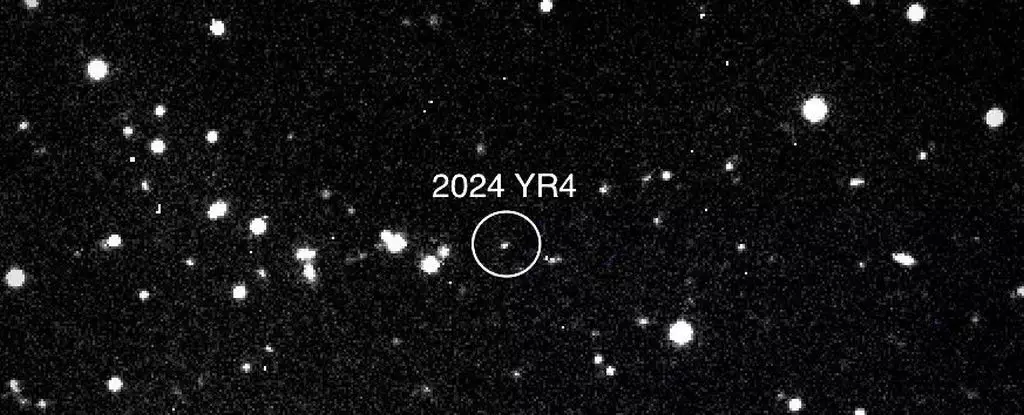In the grand theatre of the cosmos, where asteroids roam like ancient warriors on celestial horses, the return of the asteroid 2024 YR4 serves as a stark reminder of our place in the universe. Initially discovered just a few days after Christmas in 2024, this so-called ‘city killer’ momentarily cast a shadow over the joy of the holiday season. With a minuscule yet hauntingly real probability of impacting Earth, it underscored the vulnerability of our planet and, by extension, humanity itself. While the odds of YR4 colliding with Earth remain statistically negligible—at a mere 0.001 percent—the very notion of an impact stirs both curiosity and dread.
The Moon: A Possible Target
However, what is more troubling isn’t merely the risk to Earth but the potential danger to our lunar companion. A report led by Andrew Rivkin, a planetary astronomer at Johns Hopkins University, indicates that while an Earth impact has been ruled out, the Moon may still find itself in the asteroid’s line of fire come December 2032. The findings presented raise unsettling questions: What exactly would an impact with the Moon entail? And why should we care?
It’s easy for the public to dismiss such incidents as mere inklings of scientific inquiry, but the implications are enormous. The Moon has long been a foundational pillar of human culture and science. An impact event could disrupt not just its surface, but possibly impact Earth itself in ways we can’t currently comprehend. Perhaps we should consider this an issue that warrants more attention than it currently receives.
Detailing the Beast: Size and Composition
Further analysis reveals that 2024 YR4 is no minuscule speck in space; it measures around 60 meters, approximately 197 feet across. This size elevates the asteroid from a harmless rocky wanderer to a significant threat—a realization hard to process. Rivkin’s team discovered that if YR4 were to collide with Earth, the fallout could unleash energy ranging from a staggering 2 to 30 megatons of TNT. To put this into context, the most powerful bomb ever tested by the United States produced 15 megatons.
Such numbers should rattle the complacent. For something we can barely spot drifting through the vastness of space, the destructive capacity is disconcertingly vivid. When one considers the Tunguska event of 1908—a meteor airburst that levelled over 2,000 square kilometers of forest—the frightening prospects of a collision become tangible. The potential for catastrophic consequences requires us to confront our own hubris as we assert our dominance over this planet.
Science and the Unknown
Despite the apparent lull in immediate danger, these findings indicate the impending need for comprehensive observational efforts. Scientists are slated to conduct additional observations using the James Webb Space Telescope in 2025 and again in 2026, and these upcoming windows of opportunity are critical for refining our understanding of YR4’s trajectory. With a universe as dynamic and unpredictable as ours, it is imperative to stay vigilant.
Yet, there’s an unsettling sense of irony in our plight. Although we advance in technological capability, the reality is we may often be at the mercy of forces larger and more complex than we can fully comprehend. Having intelligent minds diligently watch the skies is comforting, but it also raises unsettling questions about the effectiveness of our global cooperation and prioritization of astronomical threats in policymaking agendas.
The Patterns of Neglect
The conversation surrounding asteroids and their potential impacts rarely gains traction unless a more sensational event catapults it into the public consciousness. Why is it that we only pay attention to such topics when a clock is ticking? Instead of waiting for a catastrophic event to draw our gaze, we ought to be proactively addressing these existential threats.
Political leaders must understand that neglecting scientific insight not only jeopardizes safety but diminishes the quality of life on Earth. The time has come for a shift in perspective—policies that advocate for scientific exploration and monitoring of near-Earth objects must become non-negotiable. Ensuring that we harness scientific knowledge effectively and integrate it into our socioeconomic frameworks will be vital for our survival as a species.
In an increasingly interconnected world, we cannot afford to dismiss space as an abstract concern divorced from our daily lives. As we continue to chart the cosmos, let’s not lose sight of our insecurities looming just beyond our atmosphere.

Leave a Reply